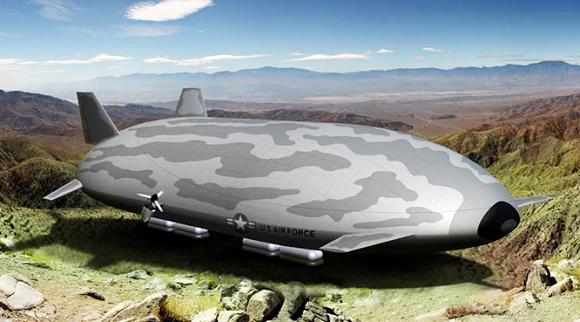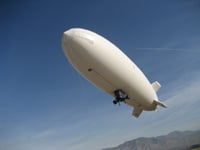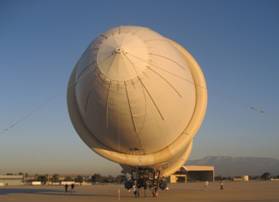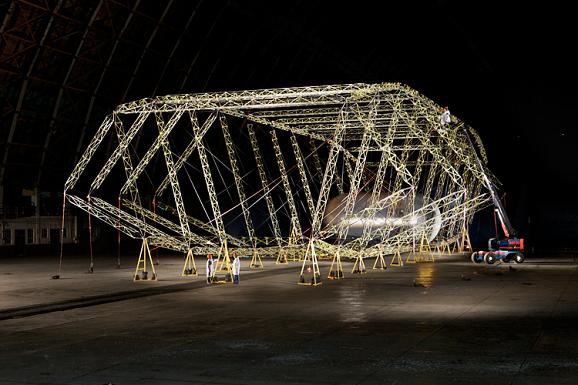Original URL: https://www.theregister.com/2011/05/06/aeros_pentagon_deal/
MIRACULOUS new AIRSHIP set to fly by 2013
Helium buoyancy issue solved at last?
Posted in Science, 6th May 2011 13:10 GMT
Intriguing news on the airship beat today, as it is reported that a mysterious, well-nigh miraculous new technology – one which could potentially lead to the appearance of enormous aerial vessels fit to dwarf even the zeppelin leviathans of the 1930s – is to get flight trials within two years.

Walrus isn't dead, just resting.
The technology in question is the enigmatic Control Of Static Heaviness (COSH) kit developed by Ukrainian airship visionary and entrepreneur Igor Pasternak at his Californian firm Aeros, which the Reg reported on a couple of years ago.
COSH purports to offer an answer to one of the knottiest problems facing airship designers today: that of controlling buoyancy while losing weight. In order to move about, an airship must burn fuel, so becoming lighter. More seriously, in order to operate, it will often need to drop off cargo or passengers. In either case the ship will become more buoyant and tend to ascend more and more powerfully.
This is bad, because pressure decreases as the ship soars upward, causing the lifting-gas cells inside it to expand. It's normal for part of the ship to hold air at surface level, allowing the ship to reach a decent altitude safely, but enough uncontrolled buoyancy will loft the vessel to "pressure height", where expanding gas cells have driven out all the air and fill the ship completely.
At pressure height, automatic valves open and start venting off lifting gas to prevent the ship bursting. It may be possible to regain control and achieve a safe landing in the end – though not always – but a lot of gas will definitely be gone until the ship can be refilled. This will also be true if the pilot vents gas in advance, so as to prevent a dangerous excursion above pressure height. Either case is unacceptable, as nice safe helium costs far too much to be thrown away whenever cargo is dropped off or fuel burned. Nobody has been willing to use cheap but highly-flammable hydrogen since the Hindenburg disaster.
There are various existing solutions to this problem, but all have their disadvantages. If a ship is delivering people and cargo at a properly-equipped mooring mast, it can take on water ballast through a nose connection at the same time, so remaining neutrally buoyant. Fuel burn while airborne can be dealt with by recovering an equal weight of water from engine exhaust using condensers. These systems were used successfully in the US Navy's 1930s helium airships, USS Akron and Macon.
One can also deal with fuel burn – though not cargo dropoff – by running one's engines on gaseous fuel mixed to have the same density as air and stored within the envelope. The famous interwar dirigible airliner Graf Zeppelin used this system, filling about a third of its hull with "Blaugas". As this was burned in the ship's diesels it was replaced by air weighing the same amount, and so the zeppelin's buoyancy was unchanged: this meant no need to vent off lifting gas during a voyage and thus no need to replenish it afterwards. Though the Graf used cheap hydrogen for lift rather than scarce, expensive helium, laying on hydrogen supplies at the ship's Latin American destinations was seen as unacceptably troublesome.
Some modern airships have been built using neutrally buoyant fuel gas, but on the whole in today's era of helium lift designers are reluctant to return to building huge aerial bags of explosive gas – and in any case the fuel-gas system offers no help in the matter of unloading at locations where ballast can't easily be taken on.
But one of the main selling-points of an airship in today's world is its ability – potentially – to deliver heavy cargoes to places without runways, mooring masts and water-ballast supplies. That's certainly a major role seen for them by the US military today, so airship designers need to think of ways to do without such luxuries.
Some problems can only be solved with a COSH
Enter Pasternak with his COSH equipment, which compresses helium into tanks, so removing lift and adding weight. These tanks, judging by Aeros photos of test blimps, are large low-pressure affairs perhaps made of fabric or other lightweight stuff rather than conventional metal high-pressure jobs. The helium is compressed only enough that it becomes heavier than air rather than lighter – say to pressures of just a few atmospheres, no more than that inside some modern bicycle tyres. (The toroidal tanks used on previous Aeros test blimps somewhat resembled large bike tyres, in fact: a doughnut shape is particularly efficient at containing pressure.)

Aeros blimp without COSH.
Pasternak contends that COSH would allow an airship to unload cargo or passengers without taking on ballast or venting gas: instead, enough helium would be rammed into the pressurised cells to compensate for the lost weight of payload. Apparently this can be done in a practical amount of time using condenser/compressor machinery of reasonable size, weight and power requirements.
Originally, Pasternak and Aeros intended to use COSH to build a mighty "Walrus" ship for the famous military crazytech agency DARPA. The Walrus was meant to lift an entire US ground-combat battalion and all its vehicles and equipment in a single load, and drop them off more or less anywhere – ie, do so without taking on ballast.

Same blimp, with COSH. Note the doughnut tanks.
Sadly, Walrus was cancelled by Congress in 2006: perhaps reasonably enough. In order to lift its enormous load the Walrus needed to fill a large fraction of its vast hull with lifting helium, meaning that it would reach pressure height at a fairly low altitude of just 10,000 feet – putting the huge, slow titan within the reach even of basic man-portable antiaircraft missiles all along its line of flight.
Other major airship projects remain – the US Army's LEMV, for instance, and DARPA's ISIS – but these are intended to operate at higher altitudes on surveillance missions and so would not offer massive payloads (though the LEMV could perhaps serve in a cargo role if desired). Since Walrus' cancellation, however, Aeros has been left out in the cold – though DARPA has nonetheless funded a small-scale COSH demo and some work on the innovative rigid shell required for a full-fledged "Aeroscraft".
Now, however, Aviation Week reports that Aeros has new funds from the Pentagon's Rapid Reaction Technology Office. The company now expects to fly a demonstrator dubbed "Pelican" either next year or in 2013. The 230-foot Pelican will not carry any payload, but will prove the rigid aeroshell, the COSH technology and the integrated flight-control system that will use the COSH system in conjunction with vectored thrust from the propulsion (and dynamic lift in forward flight) to handle the craft and achieve full vertical-takeoff-and-landing (VTOL) performance. This last is important as many of the newer "hybrid" airship designs are not true lighter-than-air vessels: they are intended to operate in a heavy condition, in large part to deal with the issues of fuel burn and/or unloading. This means that they are likely to need to take off and/or land running, like an aeroplane: it also means that they cannot remain airborne in the event of engine failure, nor unload or load in the hover like a helicopter.
Where did the DARPA Walrus men go? Funnily enough ...
COSH, potentially, eliminates the compromises of the hybrid ships and delivers a true lighter-than-air hovership which can be heavier when it wants to be and so needs no water ballast when unloading, nor engine exhaust condensers, gaseous fuel etc.

Perhaps the next-gen COSH will use a big drum-like storage tank, though?
But in fact it would seem that COSH isn't quite miraculous enough. In the case of a ship with a large payload, Pasternak admits that COSH wouldn't allow for unassisted lighter-than-air operation. In order for COSH to handle partially-fuelled unloading without ballasting (as in the Walrus troop-dropoff mission) the ship would need to have taken off in a very heavy condition to begin with.
Pasternak suggests that a vertical liftoff could still perhaps be achieved by having powerful vectored-thrust propulsion and adding still more lift by superheating the helium at takeoff, so causing it to temporarily expand and fill almost the whole envelope, furnishing extra lift. The hot gas and powerful thrusters would get the ship airborne: once the helium had cooled and the engines were throttled back to cruise power (and props rotated sideways to get the ship moving) their efforts would be replaced by dynamic lift from the hull flying along.
It's noteworthy, though, that high-powered gas turbines will be required to furnish the necessary takeoff thrust: Pasternak intends to deal with their poor fuel economy by switching to diesels in the cruise. (One might speculate that the turbines' power would also be needed to let the COSH compressors do their work in a reasonable amount of time during the unloading.)
Another sign that COSH may not be quite powerful enough for its task is that, according to AV Week, Pasternak has also done work on water-harvesting from engine exhaust in the style of the 1930s (or of some modern airship designs). Again, it seems that COSH needs every possible helping hand to let an Aeroscraft do what it says on the tin.
Even so, however, COSH is a genuinely new airship idea and it should please airship enthusiasts to hear that it will fly again soon.
And it's not just Pasternak and the Rapid Reaction Technology Office who still believe in the Aeroscraft and the "Walrus" heavy-lift mission. One notes that Aeros counts among its staff the former DARPA manager of the Walrus programme, and lists Tony Tether – head of DARPA before Walrus was axed by Congress – as an advisor. ®